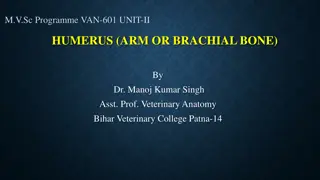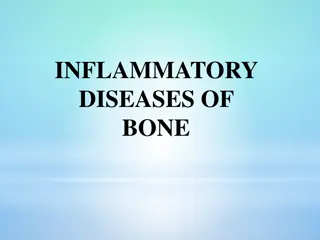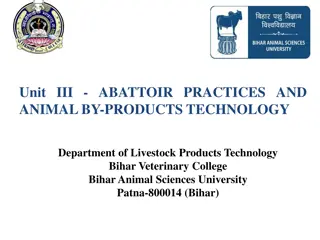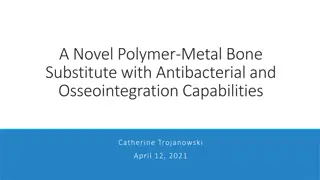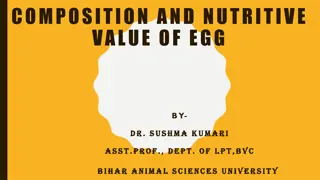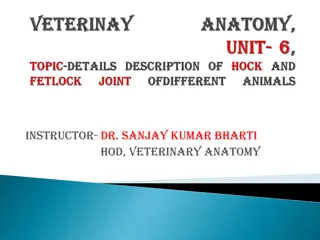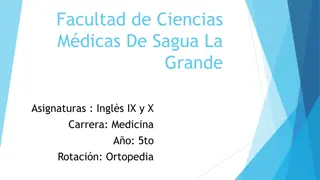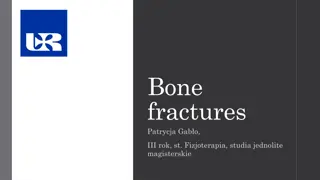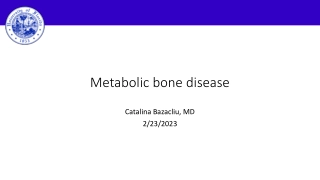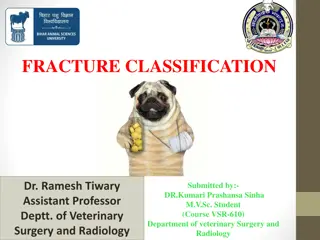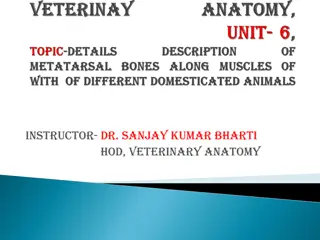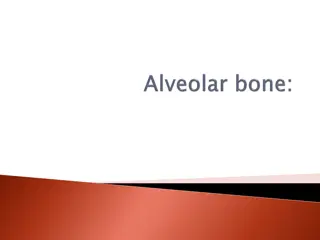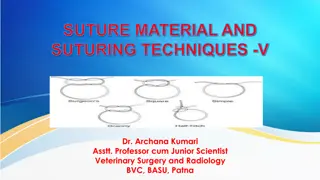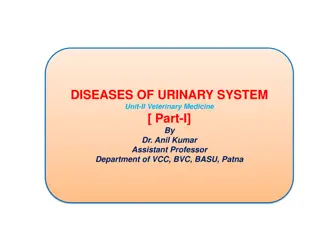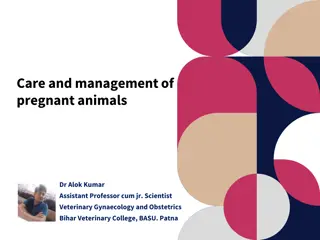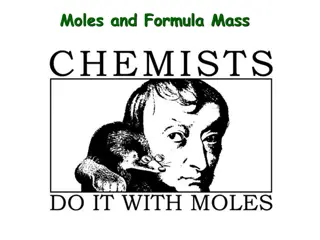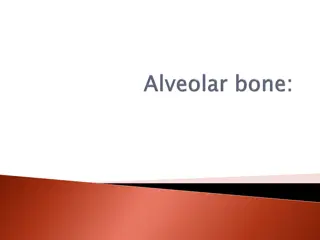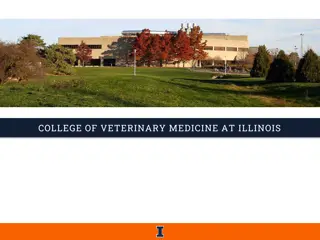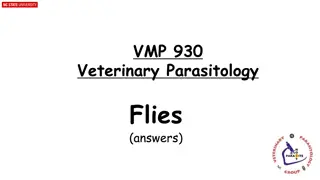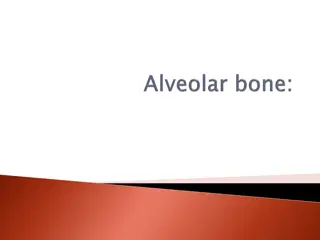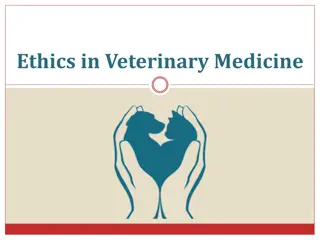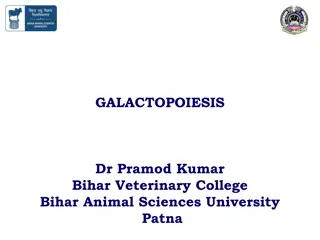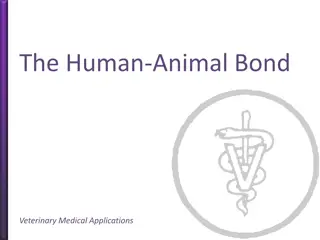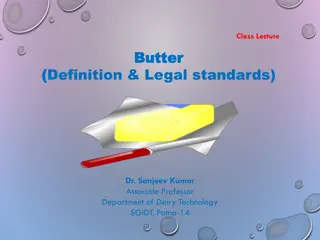Understanding Bone Development and Composition in Veterinary Science
Bone development in animals involves the differentiation of mesenchymal cells into various bone components like osteoblasts, osteocytes, and osteoclasts. This process leads to the formation of specialized connective tissue that provides skeletal support, muscle leverage, and protection for vital organs. The composition of bone includes bone cells, organic matrix, and minerals, with different types of bones classified based on shape and structure. Understanding these processes is crucial in veterinary surgery and radiology.
Download Presentation

Please find below an Image/Link to download the presentation.
The content on the website is provided AS IS for your information and personal use only. It may not be sold, licensed, or shared on other websites without obtaining consent from the author. Download presentation by click this link. If you encounter any issues during the download, it is possible that the publisher has removed the file from their server.
E N D
Presentation Transcript
FRACTURE FRACTURE - - I I . Dr. Archana Kumari Asstt. Professor cum Junior Scientist Veterinary Surgery and Radiology BVC, BASU, Patna
Development of Bone Bone is a specialization connective tissue with mineralized collagenous framework providing skeletal support to the body. acts as lever for muscles gives form to soft tissues protects the vital organs and helps in the locomotion of the animals also serves as a mineral bank. Embryonic stage development of a bone takes place from the mesenchyme, a diffuse loose cellular tissue lying between ectoderm& endoderm of the embryo
Composition of bone The bone is composed of three major components bone cells, organic matrix and Minerals The bone cells include osteoblasts, osteocytes osteoclasts, These cells are derived from undifferentiated mesenchymal cells (osteoprogenitor cells).
Mesenchymal cells also differentiate into: Cartilage Fascia Ligament Tendon
Cont. An early stage of development, the skeletal structure appear as dense concentration of mesenchymal cells that tend to take shape of particular bones These localized areas of bone formation are called Ossification Centres Ossification may be heteroplastic endochondral or intramembranous depending on the environment in which the bone formation takes place. A bone formed in tissue other than the skeleton is called a heteroplasic bone (exception : os penis of dog , os cordis of bovine & os phrenic of camel)
Types of bone Based on the shape, bones can be classified as long bones short bones flat bones Long bones are present in limbs eg. Femur, humerus, tibia and radius etc. Short bones are mainly seen in the joints-carpals and tarsals. flat bones are present in skull, pelvis and ribs.
Types of bones Based on the structure, bones can be classified as cortical bone compact bone cancellous or spongy bone Compact bone is found largely in the shafts or long bones that surround the marrow cavity. Spongy bone is found in the vertebrae, flat bones and in the ends of long bones.
Intramembranous Ossification Mesenchymal cells differentiate into osteoblasts Osteoblasts begin to secrete intercellular substance of the bone intercellular substance replaces amorphous fluid and encloses the osteoblasts and are called as osteocytes Actively secreting osteoblasts, line the surface of newly formed spicules of the bone and continue to grow in a radial manner producing trabeculae Branching and forming of different trabeculae result in scaffolding The bone formed by the scaffolding trabeculae is termed as cancellous bone The continued deposition of fresh bone lamellae on trabeculae & appositional bone growth forms the compact bone The surface connective tissue becomes the periosteum
Endochondral Ossification The process by which the bone is formed in a cartilaginous environment is called endochondral ossification Mesenchymal cells differentiate into chondroblasts Cartilage model increases in length and width by interstitial as well as appositional growth It involves :- 1. proliferation 2. Maturation 3. Enlargement of chondrocytes
Cont. The earliest chondrocytes of the centre matures, Enlarge and secrete alkaline phosphatase into the intercellular substance and becomes calcified A new vascular environment is created which with the invasion of perichondrium by blood vessels it brings change in the behaviour of pluripotential cells of perichondrium These cells differentiate into osteoblasts and a thin layer of bone is laid around the cartilage . Membrane enclosing the cartilage model is called periosteum.
Cont. formation of secondary ossification centre helps in the growth of bone The young cartilage at each end of the model continues to grow and extend by interstitial growth to increase the length of the model The cancellous bone in the central part is reabsorbed to form a medullary cavity and later on filled with myeloid tissue.
Anatomy Of Long Bone Long bone is divided into three parts : Epiphysis : present on both the ends of a bone and is composed of trabeculae Metaphysis : composed of trabecular bone which contains haematopoietic elements Diaphysis : hollow tube of cortical (compact) bone .its central cavity contains the medullary arterial supply
. The entire surface of a long bone , except at the ends at which articular cartilage is present is covered by the periosteum. The periosteum consist of an : Outter fibrous layer Inner osteogenic layer (cambium )
Blood supply Divided into 3 main compartments:- Afferent vascular system arteries and arterioles carrying nutrients i. Efferent vascular system veins and veinules carrying waste products ii. Intermediate vascular system capillaries linking afferent and efferent vascular system iii.



